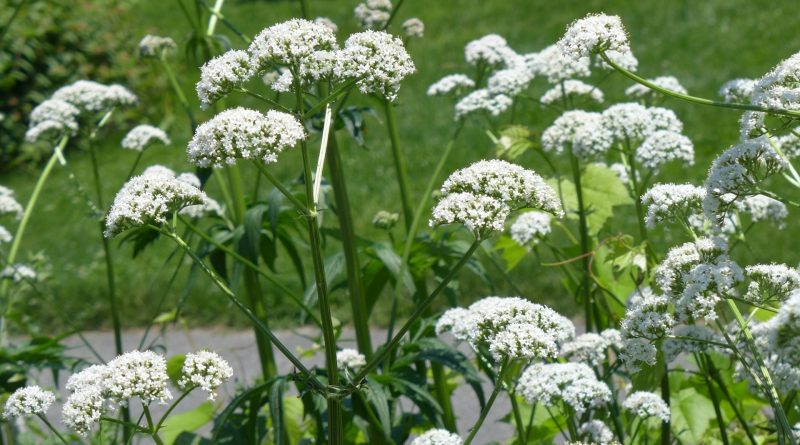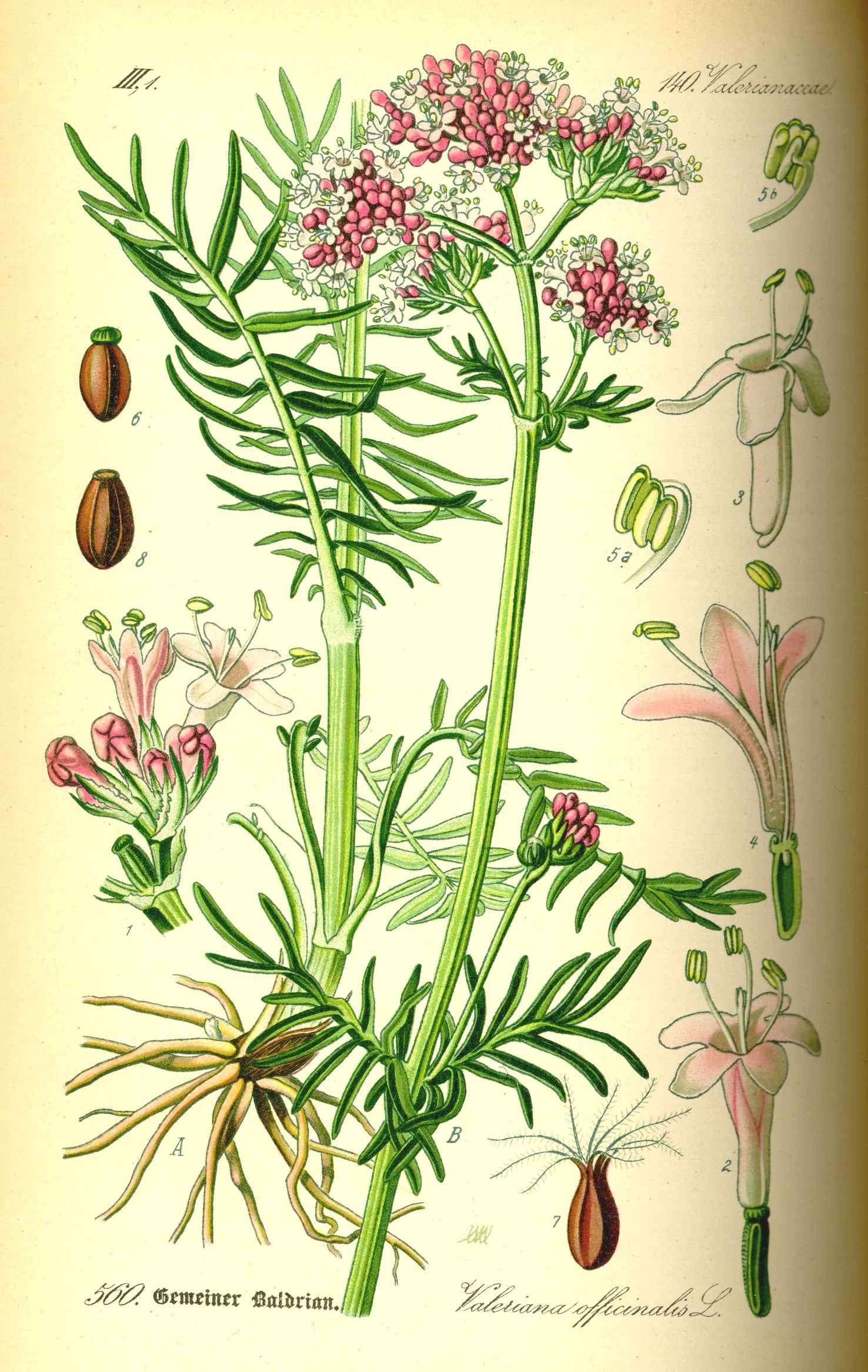Valeriana officinalis
Valeriana officinalis
Valerian (Valeriana officinalis L., 1753) is a flower plant belonging to the Valerianaceae family. Among the Valerian is the most famous of a genus, consisting of more than 150 species.
Systematic –
From a systematic point of view, the common valerian belongs to the Eukaryota Domain, the Kingdom Plantae, the Magnoliophyta Division, the Magnoliopsida Class, the Dipsacales Order, the Valerianaceae Family, and then the Valerian Genus and the Specie V. officinalis.
Etymology –
The generic botanical name derives from Latin “worth” = good, and as the specific name refers to the plant’s medicinal use. The popular name, cats herb, comes from the fact that the fresh plant has an “astonishing” cat-like attraction and is perhaps the reason why, although decorative, it rarely meets the gardens.
Geographic Distribution and Habitat –
Valeriana officinalis prefers especially fresh and moist environments (mesophytes) and grows spessp at the edge of the woods and shady meadows up to an altitude of 1,400 meters. This species is most common in European forested areas and, to a lesser extent, in North America and South American tropical regions.
Description –
The valerian is a herbaceous and perennial plant with a short stolonous rhizome, a stem erected and grooved on the surface by grooves, fibrous roots emanating an unpleasant and penetrating smell; this species, in optimal conditions, can reach heights of about 150 cm.
It has opposite and no leafs, with petioles present only in the lower ones (the upper ones are sessile); all the leaves are composed and imparipennate, consisting of 11-19 sheets of whole or toothed sheet and a beautiful intense green color.
The flowers are slightly scented and are found to form a particular type of inflorescence which is the corimbo; these are hermaphrodite flowers, with a small goblet and a corolla with 5 petals, tubular and light pink; the androceum is composed of 3 stamens, the gynecologist by a tri-carpellar pistil with inferior and unilocular ovary. The flowering of this species takes place in April-June and the pollination is entomogama (ie through Insects).
The fruit of the Valeriana officinalis is a striated achenio with plumage bristles resulting from the modification due to the fact that the small calico teeth undergo maturation. Their presence helps them disperse through the wind.
It is a bitter grass with a musky aroma; hypogeous parts are collected for hypotensive, sedative, anxiolytic, diuretic, antispasmodic, anticonvulsant, analgesic and antinevracial properties.
Cultivation –
For the cultivation technique, see the following sheet.
Uses and Traditions –
The use of Valerian as an inducer is ancient and was described in the 4th century BC by Hippocrates, the father of modern medicine. The valerian having an unpleasant odor, formerly called it, was the term Valeriana appeared for the first time around the tenth century. Dioscoride advised her as a diuretic and antidote against poisons, Pliny considered her an analgesic, while Galen prescribed her as a decongestant.
Already in the twelfth century the German herb and herbalist Hildegard von Bingen recommended Valeriana as a tranquilizer and sleeping pills. In the thirteenth century, in order to release Hamelin, a German village, the elders hired a traveling flute player. In the modern version of this story, the powers of Piper reside entirely in music, but the old German folklore attributed to Piper herbal knowledge and it seems that just with Valerian root was able to hypnotize mice and children.
The common name of “Catfish” comes from the fact that the fresh plant has an “astonishing” attraction on cats. It contains chemical substances similar to those in the nephew.
Mattioli writes about cats “… they are very fond of Valerian and they marvelously love the cats, so they get very distant and eat it greedily.”
From the observation of these phenomena came the conclusion that this herb acted somehow on the nervous system. Fabio Colonna (1567-1640) abandoned forensic activity because of her health she devoted herself to the study of medicine, natural history and botany, soon becoming an expert in the field. Epilepsy affection wanted to cure with the dust of this plant and thus came to discover its anti-epileptic properties. In the same period Lazàre Riviére (1589-1655), a physician of Montpellier, after experiments on his patients, he came to the same conclusions, believing Valerian has a curative effect on the SCN and thus considering it effective in the treatment of epilepsy.
The first settlers arrived in the new world, discovered that several Indian tribes used the sprouted roots of the American spontaneous species of Valeriana to cure the wounds.
Valeriana entered the US Pharmacopoeia as a tranquilizer in 1820 and remained there until 1942.
During the First World War became in Europe, a common remedy to counteract the stress caused by continuous artillery shelling, as well as during World War II, it was used in England to relieve stress caused by air raids and was very successful in curing of traumatic psychosis.
Today valerian is used primarily to fight anxiety, sleep disorders, panic attacks, tachycardia, etc.
In summary it is indicated against: anxiety, stress, cramps, depression, dysmenorrhea, insomnia, urticaria, hypochondria, hysteria, colic, menopausal irritability, migraine, nervousness, palpitations, muscle aches.
In herbal therapy, dyeing is used, sometimes combined with other sedative herbs, such as melissa or hops. In modest doses (below the amounts indicated in the posology), the remedy can have a paradoxical effect because it becomes an exciting one. Used to ease sleep does not have the classic effects of hypnotics and therefore does not cause mental heaviness upon awakening. It is present in the pharmacopoeia of many countries where it is on the market both in pharmaceutical and herbal preparations. It is used as infusing, dyeing, capsules, tablets.
For internal use in case of insomnia, hysteria, anxiety, cramps, migraine, digestion difficult for nerve causes, hypertension, painful menstruation. This herb is considered a valid alternative to benzodiazepines for the treatment of transient sleep disorders.
For external use in the event of eczema, ulcers and minor injuries, to relieve the pain of bruises, lumbago and muscle strain.
Oil is used in the production of musk scents.
The extracts can be used to flavor ice cream, bakery products, soft drinks, beer and tobacco drinks and are particularly important in apple flavor; unfortunately used, even as a bait in traps for rodents and wild cats.
The valerian parts used are the roots, in which we find the elements that make it an excellent sedative. Valerian should not be consumed by young children or women who are breast-feeding or pregnant.
As we have said and most of us know, valerian is a very calming and excellent aid for those who suffer from insomnia; be careful not to exaggerate with the doses; ingesting too much quantities can cause headaches, dizziness, fogging, nausea and vomiting.
Popular Medicine has known and used the Valeriana since time immemorial.
All valerian species contain the following components: essential oils (valerianic acid esters, valerenic acid, cariofillenes, terpinolene, valerenol, valerene and diterpene compounds known as iridoids); some alkaloids (valerine, actinidine, catinine and alpha-pyrrylonone); of flavonoids (linarine, 6-methylapigenine and esperidine).
The part you use is the root of the plant, however, as it is said, has an unpleasant odor.
The mechanism of action of its constituents is quite well known. Valerian acid esters and iridoids must be inhibited by the gamma-aminobutyric acid transaminase animal enzymes, which is responsible for the metabolic degradation of the gamma-aminobutyrate neurotransmitter (GABA). This chemical mediator is known to be associated with inhibitory neuronal phenomena and is also responsible for the induction of sleep in humans.
Recent studies have shown that even some of the alkaloids may have more or less direct influence on GABA metabolism, but their mechanism is still unclear. Finally, some terpenes and flavonoids appear to be agonists with adenosine receptors (those inhibited by caffeine) and are partly responsible for the self-inducing, spasmolytic intestinal action and reducing blood pressure.
Contraindications to follow are those not to be administered to children under 6 years of age or to pregnant or lactating women. It can also not be used by those who have kidney problems because it is diuretic or if they take medicines against insomnia, antihistamines, psycho-drugs and narcotics because they are likely to end up in a catatonic state. Valerian that is not recommended during pregnancy unless very tiny and under the supervision of a doctor is not recommended for people with low blood pressure and hypoglycemia. Additionally, the intake of Valeriana may produce a slight reduction in attention and concentration. Prolonged intake may include headache, gastrointestinal disorders, restlessness, agitation, insomnia or daytime sleepiness, and difficulty awakening in the morning. No contraindication to normal therapeutic doses is reported in the literature, but Valeriana officinalis should not be used concomitantly with benzodiazepines or barbiturates because it may cause an increase in SNC depression; with opioids and ethanol because it can increase their sedative effect. Finally high doses of valerian extract can endanger the liver and central nervous system as well as lead to lethargy.
Preparation Method –
The most common way to use valerian is in herbal teas or in pills: you can use dehydrated leaves that are in the herbalist or just do it by taking the fresh valerian and putting it into the infusion for 10 minutes in boiling water, then filtering and drinking .
In the kitchen, it is often used to prepare pancakes or even as an ornament for salads, tomatoes and cold dishes with moderation. For example, if you decide to prepare pancakes with valerian, you must ensure that there is also a “strong” ingredient inside them , for example, because in itself the taste of valerian is bitter and therefore needs to be balanced as well as balancing its soothing property, to prevent guests from hanging on your couch in sleepiness.
With the valerian, the following preparations are then prepared:
Infused: 2-3 g per cup from 1 to several times a day;
Dye: 1/2 – 1 teaspoon of 1 to several times a day;
Extracts: the dose corresponding to 2-3 g from 1 to several times daily;
Pills: 3 capsules per day.
Guido Bissanti
Sources
– Wikipedia, the free encyclopedia.
– Treben M., 2000. The Health of the Lord’s Pharmacy, Tips and Experiences with Medicinal Herbs, Ennsthaler Publisher
– Pignatti S., 1982. Flora d’Italia, Edagricole, Bologna.
– Conti F., Abbate G., Alessandrini A., Blasi C. (eds.), 2005. An annotated checklist of the Italian vascular flora, Palombi Editore.
Caution: Pharmaceutical applications and surgical uses are indicated for information purposes only; they do not represent any prescription of a medical type; Therefore, any responsibility for their use for the purpose of healing, aesthetics or food is refused.


